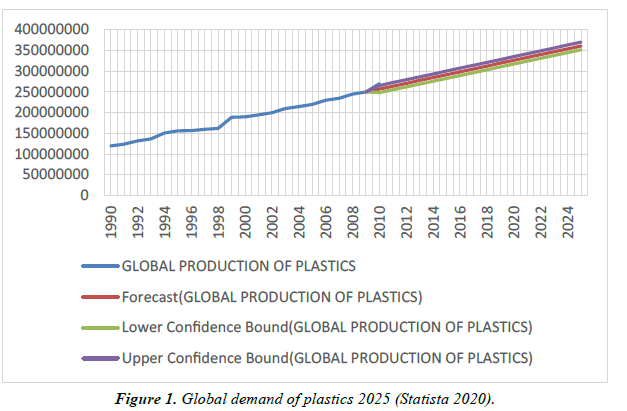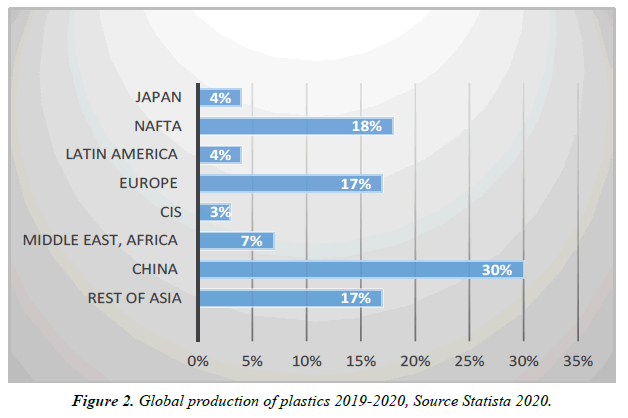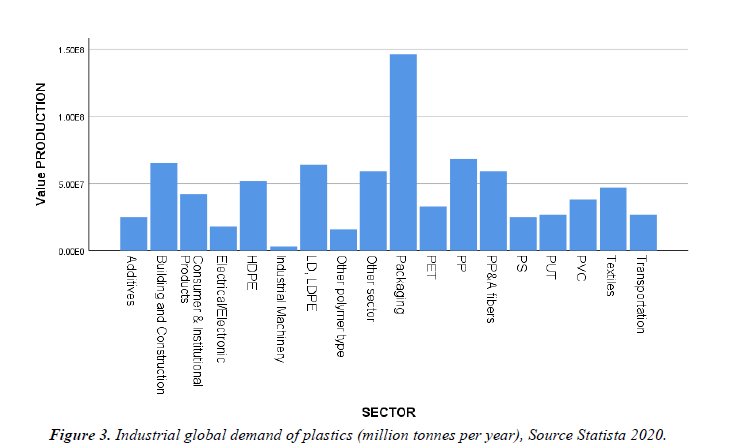Review Article - Environmental Risk Assessment and Remediation (2022) Volume 6, Issue 8
Plastic replacement alternatives need of the hour: A critical analysis of the rising global demand of plastics
Shaili Vadera*
Departmentof Accounting & Finance, Prince Mohammad Bin Fahd University, Saudi Arabia
- *Corresponding Author:
- Shaili Vadera
Departmentof Accounting & Finance
Prince Mohammad Bin Fahd University
Saudi Arabia
E-mail: svadera@pmu.edu.sa
Received: 01-Aug-2022, Manuscript No. AAERAR-22-138-Pre QC 22; Editor assigned: 03-Aug-2022, PreQC No. AAERAR-22-138-Pre QC 22(PQ); Reviewed: 17-Aug-2022, QC No. AAERAR-22-138-Pre QC 22; Revised: 22-Aug-2022, Manuscript No. AAERAR-22-138-Pre QC 22(R); Published: 29-Aug-2022, DOI: 10.35841/2529-8046-6.8.138
Citation: Shaili Vadera. Plastic replacement alternatives need of the hour: A critical analysis of the rising global demand of plastics. Environ Risk Assess Remediat. 2022;6(8):138
Abstract
The paper critically examines the rising global demand of plastics including the role of major countries responsible for the mismanaged plastic waste by 2025. It also outlines the growing importance of adopting Plastic Replacement Alternatives as global solution to mitigate plastic pollution. Plastic pollution affects the health of millions of people around the world. Synthetic plastics are slow to degrade posing a huge threat to the entire ecosystem. Recent studies conclude that human beings are daily consuming bits of micro-plastics through food and water. Microplastics have also been found in 90% of the packaged drinking water. Approximately 9 million tons of plastic waste is disposed annually and it is expected to double by 2025. If present trend continues there will be more than 18 billion metric tons of non-biodegradable plastic both in land and oceans. Also, due to recent Covid-19 pandemic, there is a sudden increase in demand for single-use plastic items.The problems related to post pandemic plastic pollution will become even more complex requiring a collaborated and sustainable approach in collection and effective disposal of plastic waste in order to mitigate its harmful impact on the environment.
Keywords
Plastics, Global demand, Mismanagement, Pollution, Biodegradable alternatives, Sustainability.
Introduction
Plastics are one of the most versatile man made materials. It has been reported that more than 2 million plastic bags and bottles are currently being consumed by packaging industry every day [1]. Plastics are currently in demand in all the sectors. The current demand for plastics in packaging industry is around 36% followed by building and construction at 22% and the rest 42% required in other key sectors such as electronics, furniture, transport, agriculture, medical, toys, etc. The future production of plastics is set to double by 2030. Due to slow rate of degradation and inappropriate disposal mechanism there is gradual accumulation of global mismanaged plastic waste in the environment [2]. The accumulated plastic waste is continuously broken down into toxic micro particles by extreme weather conditions causing irreparable damage to the entire ecosystem. It is also responsible for polluting freshwater bodies and other habitats. More than 9 million tons of plastic waste is dumped in the oceans every year which is expected to double by 2030. Plastic waste dumped in oceans and water bodies is causing high risk to the aquatic life. It is also found that quantity of plastic remains/debris is six times more in relation to the quantity of oceanic planktons (flora) which produce 70% to 80% of total oxygen on earth. Also, plastic debris has also been found inside the gut of dead marine animals. Fishes and other aquatic animals are directly consuming micro particles of plastics which smell as food covered by algae and fungi. This plastic is getting accumulated in the gut and tissues overtime which is causing death of many fishes and other aquatic animals due to starvation. Therefore, it is also affecting the food chain in the entire ecosystem. According to a recent study on marine species there will be acute shortage of sea food if dumping of plastic waste materials is not controlled in the coming years [3].
Literature Review
Plastic term comes from the Latin word ‘plasticus’ and the Greek word ‘plastikos’ signifying 'ready to be shaped' or 'formed.' Plastics are largely used as packaging materials. Plastics have substantial benefits in terms of being light weight, durable, flexible and cost effective as compared to other alternative packaging materials. Plastics are among the most sought after man-made material [4]. According to European Bio plastics, there are more than 30 types of plastic polymers. About 95% to 99% of these plastics are derived from petroleum sources while the rest 3% to 5% are derived from biodegradable (compostable) plant sources. The commonly used plastics are mostly derived from non-renewable sources such as polypropylene, polyethylene, polyvinyl chloride and poly (ethylene terephthalate). On the other hand, biodegradable plastics are produced from renewable plant sources, recycled food waste, by-products including compostable and oxybiodegradable plastics etc. [5,6]. Plastics are commercially used in many sectors including manufacturing, construction, medical industry, packaging, agriculture, furniture, household appliances, electronics etc. Currently 85% of plastics are used in the production of medical equipment’s including surgical gloves, disposable syringes, sterile packaging for medical instruments, dental implants and bridges, catheters, joint replacements, intravenous bags, insulin pens etc. In addition, 70% of the ‘single-use plastic’ is commonly used for packaging purposes (Figure 1).
However, there are significant challenges related to economic, social, technological and environmental implications of production and consumption of plastics [7]. There is gradual accumulation of discarded plastics in landfills and oceans. Plastic waste can physically harm wildlife. Plastic debris can be found littered on beaches, floating on the surfaces, and submerged at the bottom of all water bodies. Micro-plastics are often eaten by aquatic animals as food covered by algae. It is majorly responsible for filling their guts causing death due to starvation. There is significant evidence regarding the harmful effects of accumulated plastic garbage on 300 aquatic species including 90% of ocean turtles, 40% of seabirds, and 70% of marine animals. Improper disposal of plastic waste is also affecting tourism sector in many ways. Recycling is an effective waste-management strategy, although very limited amount of the plastic has been recycled till now [8]. Asian countries with growing consumer markets are responsible for more than 70% of the plastic pollution. Ironically, substitutes like wood, metal and glass contribute to significantly higher environmental costs as compared to plastics. Therefore, there is a need for thorough investigation regarding the environmental impact of plastic production, consumption, disposal and availability of substitutes to mitigate plastic pollution [9].
Research Methodology
It is an exploratory study based on identifying the underlying issues related to plastic production, consumption patterns and applications in various industries (Figure 2). Secondary data was analyzed using statistical software for forecasting global demand of plastics, identifying major countries responsible for mismanaged plastic waste and exploring plastic replacement alternatives as solutions to tackle the growing plastic pollution around the world [10].
Forecasting global demand of plastics by 2025
The resurgence of global plastic industry has been witnessed since World War II. The global demand of plastics has increased 10 times in last 30 years. The global plastics market was valued at $570 billion in 2019. It is expected to grow at 5 percent every year (Figure 3). Plastic production growth rates indicate that production could double by 2025 to increase four times by 2050. Asian countries accounts for more than 70% of the global plastics production and consumption [11].
Discussion
Plastics are extremely versatile and unavoidable due to their multiple uses and characteristics. But the level of harm it is causing to our environment, because of its non- biodegradable nature, has forced countries to invest heavily in R&D labs, to seek compostable eco-friendly plastic alternatives [12]. However, the main limitation of compostable products is that they require industrial treatment in compostable industrial centers facilities which are also limited in number. For the last two decades, there has been an emphasis on living “green” and exploring environment friendly plastic alternatives. There is an urgent need to shift the focus to biodegradable alternatives to reduce the menace of plastic pollution. For example- Starch as a totally bio-degradable, low cost natural polymer has been receiving lots of attention these days. Starch when blended with aliphatic polyesters can be used to produce completely biodegradable as well compostable trash bags. These bags decompose when they come in contact with soil and are safe as fodder for animals also. They are economical to produce, but the starch content has to be more than 60% of the composite, in order to make it easily degradable. Increased usage of potato corn starch in making compostable trash bags can drastically help in reducing plastic pollution.
Replacement of plastic bags with cotton bags, made from 100% biodegradable material, cotton mesh is increasingly being used. Likewise, biodegradable plastics made from sugar and carbon dioxide could safely be used in producing medical implants. Production of biodegradable plastics from microalgae as well as use of ground coffee precipitate/ residue can be effectively utilized for reducing plastic consumption. Also, the use of bars instead of plastic shampoo bottles, detergent and other liquids are other possibilities to reduce plastic footprint. A company in New Zealand named Ehique makes soap bars from coconut oil and other such essential oils. Seeds of olives which are usually discarded in the production process can be used to produce biodegradable plastic products, which can easily be decomposed into fertilizers within one year. Limex made from calcium carbonate can also be used as a substitute for plastic. Moreover, the basic raw material used in this is limestone, which is abundantly available in many parts of the world. Bamboo and sandalwood are also in use to create biodegradable water bottles which have shelf life of about two years.
Single use plastics and packaging material are one of the major causes of environmental pollution which has lead countries and communities to focus on producing biodegradable plastic products. For example most commonly used packaging materials used today are made from foaming technology and Nano-cellulose. Plastic straws take somewhere between 450 years to decompose so biodegradable straws are being produced made from plant parts, grass, bamboo and metal. Companies are also investing heavily in nanotechnology used for making packaging material of paper or cardboard. There has been a focus on creating edible cutlery. Not only our environment, but also our bodies are getting damaged with excessive use of plastics. As it is observed that 90% of packaged water bottle contains traces of plastic therefore, edible water bottles are being produced from sea weed extracts. Also paper bottles are replacing plastic bottles. Similarly, edible forks, spoons, cutlery and chopsticks made with a combination of sorghum, wheat, pulses, spices and rice flour are baked in various shapes which can be easily consumed. Edible cutlery in hot liquid usually lasts for more than an hour, so it can be consumed as it is made from edible spices which have medicinal benefits. Plant based tooth brushes, where even the packing boxes are made from bamboo, helps in reducing the waste that goes to landfills in the form of plastic toothbrushes. Also the use of bamboo as a replacement for plastics can provide boost to bamboo farming and supporting the livelihood of tribal population which are instrumental in creating eco-friendly products in developing countries. However, plant based sanitary napkins are currently made from corn or bamboo fiber has the ability to decompose in just six months after disposal.
Therefore, there is a need for global coordination and participation between governments, communities, industry associations, municipal waste management corporations, suppliers, retailers, consumers and not-for-profit organizations in order to sustainably execute and implement the circular economy model related to 7R’s.
Conclusion
The global demand for plastics is continuously increasing at a rapid pace. Plastics being light weight, durable, versatile and cost effective find number of applications in key sectors such as cosmetics, packaging, transportation, building & construction, textiles, consumer products, electrical etc. Due to such large scale production and consumption there is a growing concern related to increase in mismanaged plastic waste. Due to high cost of recycling most of the mismanaged plastic is conveniently discarded in landfills. Also, there are growing challenges to recycle all the single-use plastic that is accumulating in the environment. For the last two decades, there has been an emphasis on living green and finding out environment friendly plastic products. Numbers of initiatives are being adopted at national and global level to redesign, reduce, reuse or recycle waste plastics by adopting circular economy model. It is the need of the hour that firms invest in R&D labs; seek biodegradable alternatives as replacement for synthetic plastic polymers including innovative packaging material, products and processes to mitigate the harmful effects of plastics. Countries need to impose regulations to import oxy-biodegradable single-use plastics only and enforce complete ban on usage of non-biodegradable plastics. Collaborated efforts are required by countries around the world to discourage single use plastics, adopt compostable and biodegradable plastic products and recycle the existing mismanaged waste to provide a cleaner and sustainable environment for the coming generations.
Acknowledgement
None
Conflict of Interest
The authors declare no conflict of interest.
References
- Andrady AL. Microplastics in the marine environment. Mar Pollute Bull. 2011;62:1596-605.
- Barnes DKA, Galgani F. Accumulation and fragmentation of plastic debris in global environments. Philos Trans R Soc Lon B. 2009; 364(15):1985-98.
- Bennett SJ. Implications of climate change for the petrochemical industry: Mitigation measures and feedstock transitions. Han clim chan mitig adapt. 2012;319:383-426.
- Frosch R. Strategies for manufacturing. Sci Am. 1989;261:144-152.
- Geyer R. Production, use, and fate of all plastics ever made. Sci Adv. 2017;3(7):e1700782.
- Blanco I, Loisi RV. Agricultural plastic waste mapping using GIs a case study in Italy. Res Conser Recy. 2018;137:229-242.
- Hopewell J, Dvorak R, Kosior E. Plastics recycling: Challenges and opportunities. Philos Trans R Soc. 2009;364:2115-2126.
- Kirchherr J, Reike D, Hekkert M. Conceptualizing the circular economy: An analysis of 114 definitions. Resour. Conserv. Recycl. 2017;127:221-232.
- Lebreton L, Zwet JV, Damsteeg JW, et al. River plastic emissions to the world’s oceans. Nat Com 2017;8(1):1-10.
- Moore CJ. Synthetic polymers in the marine environment: A rapidly increasing, long-term threat. Environ Res. 2018;108:131-139.
- Pahl SK. Channelling passion for the ocean towards plastic pollution. Nat Hu Beha. 2017;1(10):697-699.
- Wagner M, Scherer C, Alvarez-Muñoz D, et al. Microplastics in freshwater ecosystems: What we know and what we need to know. Environ Sci Eur. 2014; 26(1):12.
Indexed at, Google Scholar, Cross Ref,
Indexed at, Google Scholar, Cross Ref,


